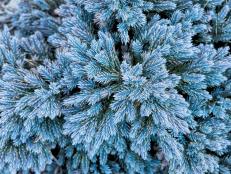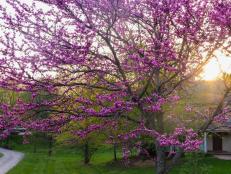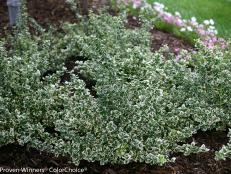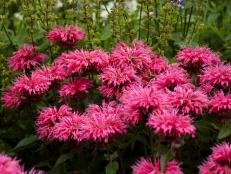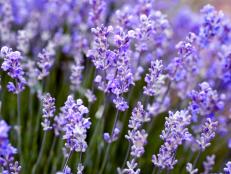How to Plant and Grow Cherry Laurel Trees
Learn all about versatile cherry laurel trees — also known as English laurel — plus get expert tips and information for choosing, planting, growing and caring for cherry laurels in your home landscape.

With its glossy foliage, fragrant white blooms and adaptability in the landscape, it's no wonder that cherry laurel — also known as English laurel — is one of the most popular selections for foundation plants, hedges and mass plantings. The lustrous leaves play the perfect foil to flowering companions during the growing season and serve as a stalwart evergreen backdrop during the winter months. With a little forethought before planting, cherry laurels will grow happily without many (if any) maintenance demands for years to come.
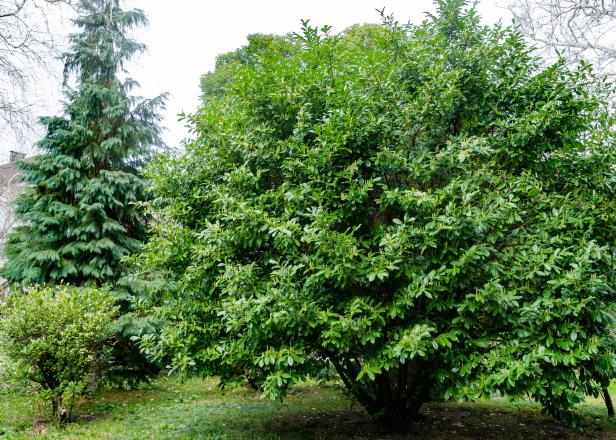
Shutterstock/Marinodenisenko
Botanical Name: Prunus laurocerasus
Common Name: Common Cherry Laurel, English Laurel
Bloom Time: Spring
Light Needs: Full sun to full shade
Hardiness Zones: 6 to 8
Height & Width: 18' high and 30' wide, with many compact varieties
Growth Rate: Medium
It's not hard to imagine why cherry laurels are widely grown in most areas of the country. Although these tough plants are mainly valued for their waxy evergreen leaves, they are also valued for their versatility in the landscape and long-lasting fragrant spring blooms. Cherry laurels will grow well in any light conditions, although they will perform better with some shade. Give cherry laurel any type of soil — as long as there isn't standing water, this adaptable plant should thrive.
Foliage size, shape and shade of green can differ dramatically between varieties. Some selections may have 2-inch-long and narrow, willow-like leaves, while others can develop 12-inch-long and 4-inch-wide leaves that look similar to a magnolia leaf. Many varieties on the market have dark forest green foliage, although some forms of cherry laurel have lighter Kelly-green leaves. Foliage may be held stark upright, horizontally or gently droop from the stem — all depending on the variety.
Cherry laurels may be grown primarily for their glossy green leaves, but they also have beautiful and long-lasting spring blooms. Sweet smelling 2- to 5-inch-long flower spikes are held above the lustrous evergreen foliage for several weeks. As the flowers fade, red fruits form then fade to black. The inconspicuous fruits are inedible to humans, but beloved by birds.
How to Use in Your Landscape
Cherry laurels thrive in just about any landscape condition with the exception of poorly drained soils. These robust evergreen shrubs are excellent foundation plants, look great in the back of flower borders, and give privacy as screening plants. Cherry laurels are salt tolerant, which means they'll perform well in roadside plantings too.
All-purpose cherry laurels handle regular hedging and shaping very well, and compact selections make an outstanding low hedge without the need for pruning and shaping. Larger varieties can be limbed up and grown as an attractive small tree.
How to Plant Cherry Laurel
Cherry laurels are usually planted in groups of three or more plants. If you're grouping multiple laurels in one planting, be sure to follow the spacing requirements on the plant label. Although it's tempting to grow small nursery plants close together for an immediate impact, rest assured that these robust shrubs will quickly fill the empty space between plants.
Dig a hole roughly 1.5 times the diameter and the same depth as the nursery container. Use a sharp spade, planting knife or hand saw to completely remove circling roots from the outside of the root ball. Once roots begin circling, they continue to grow in that direction and may eventually cut off circulation to the stem. Removing the roots will initiate new root growth, and the new roots shouldn't grow in a circle.
Gently place the root ball in the hole. Backfill around the roots with native soil. Be sure to break up any large clods before putting them in the hole. Water deeply, then spread a layer of weed-suppressing mulch on top of the soil below the plant.
Cherry Laurel Care
Hedging or Pruning
Nothing can ruin the beauty of an otherwise healthy cherry laurel like a bad haircut. There are countless examples of lazy, rushed or unnecessary pruning on cherry laurels just about everywhere they can be grown. To maximize the look of cherry laurel in bloom, it's best to hold off on trimming back until shrubs finish flowering.
Zipping around the shrub with hedge clippers makes quick work of pruning, but ultimately leads to more congested outer foliage that won't allow light and air into the interior of the plant. Lack of light will cause inner leaves and branches to die, and poor air flow creates the perfect environment for insect pests and diseases to flourish.
It's important to occasionally set aside some time to thin out the canopy instead of or in addition to traditional hedging. Use hand pruners to cut right above a side-shoot or bud just below the canopy line. Low-growing varieties like the incredibly popular 'Otto Luyken' may not need to be pruned at all, besides occasionally removing dead, diseased, or damaged branches.
Health Problems
Although cherry laurels are usually tough plants, there are a few common health issues to keep an eye out for. Remember, healthy plants usually have better resistance to pest and disease problems. Be sure to plant cherry laurels in moist but well-drained soil, don't over-fertilize, and avoid over-watering to prevent more serious health problems.
Root rot is a serious problem that will ultimately lead to the death for affected cherry laurels. Although cherry laurels are widely adaptable and will grow in most soil conditions, they absolutely won't tolerate poorly drained soils. Symptoms of root rot are very similar to signs of underwatering and include yellowing foliage, wilting stems, premature leaf drop, and branch dieback. Cherry laurels that are infected with root rot fungi will also have cankers or stains on their trunks.
Test the soil's drainage before you plant. If the water drains too slowly, you should choose a different species that will tolerate wet feet. A sudden onset of root rot symptoms on an established cherry laurel could also be a sign of a leak in an irrigation or water line.
Shothole disease is a common problem with cherry laurels. Although it doesn't look great, it's more of an aesthetic problem that usually doesn't cause serious injury. Affected plants will have many small holes in the foliage, causing the leaves to look like they've been hit with buckshot. Several species of bacteria and fungi can be responsible for shothole on cherry laurels, which means that an over-the-counter treatment without a specific diagnosis probably won't stop this disease from spreading.
Overhead irrigation will spread shothole disease. One way to limit shothole is to adjust sprinkler heads to minimize the amount of water that hits plant leaves. Remove fallen leaves from below the plant, and prune to improve air circulation. Reach out to your local extension service for help identifying the cause of your laurel's shothole disease and to discuss treatment options. Keep in mind that symptomatic leaves will not be able to close established holes. Once the disease is under control, new leaves will cover up the old shothole riddled foliage.
Scale insects are another fairly common issue with cherry laurels, especially the white prunicola scale. Scale insects hunker down and suck sap from stems and the underside of leaves. These stationary insects can completely coat stems and leaves and may look more like a disease than an insect issue.
Treat scale insects by coating the leaves and stems with horticultural oil during cool winter weather, and be sure to follow any instructions on the product label. The dormant oil will smother scale insects and limit their population the next growing season. You may need to repeat this treatment for a few years until the scale insects are under control.
In the case of a severe infestation, prune out branches that are totally coated with scale insects. Burn or bag and throw away the pruned limbs so that scales in the crawler stage don't find their way back to the plant.
Popular Cherry Laurel Varieties
Low-Growing Laurels
- 'Mount Vernon' – can be used as a lovely groundcover; especially attractive in dry shade below trees; slow grower that will eventually grow up to 2' tall and 8' wide; may grow up to 5' tall given the right conditions, but tolerates pruning well
- 'Otto Luyken' – incredibly popular in mass plantings; eye-catching leaves are held starkly upright from the stem; excellent flowering, even in shady conditions; matures to 4' x 8'
- 'Zabeliana' – another short-statured variety with good potential as a groundcover; more narrow, willowy foliage than other selections; 3 to 5' tall and 12 to 25' wide
Larger Varieties
- 'Majestic Jade' – bronze-tinted new growth matures to handsome green; a larger plant with a more rounded vase shape; matures to 12' x 10' but tolerates hedging well; more resistant to leaf spot than other common varieties
- 'Schipkaensis' – commonly called “schip laurel” or “skip laurel,” this variety is one of the most widely planted; attractive narrow forest green leaves; hardy to zone 5, this could be the most cold tolerant cherry laurel variety; there are actually a few forms of this variety that have different growth habits, from broad 3' tall selections to vase shaped forms that reach 6' or taller
- 'West Coast Schipkaensis' – this incredibly popular form of the 'Schipkaensis' variety is commonly planted in the Southeast; fast growing with an upright form; may mature to 15' in height but is typically kept much shorter by regular pruning
Other Interesting Selections
- 'Variegata' (also 'Castlewellan' and 'Marbled White') – this attractive marbled cream and green leaved form is available under a few names; keep an eye out for and trim out any green leaved reversions; this slow growing variety may reach up to 16' at maturity
- Prunus caroliniana – native Carolina cherry laurel is naturally found from North Carolina down to northern Florida, west to Louisiana and Texas; an extremely robust plant that is commonly used as a hedge; grows to 30' x 40' but tolerates pruning well; Bright 'N Tight, 'Compacta', and Cherry Ruffles are more compact varieties; spreads prolifically from seed; hardy from zones 7 to 10
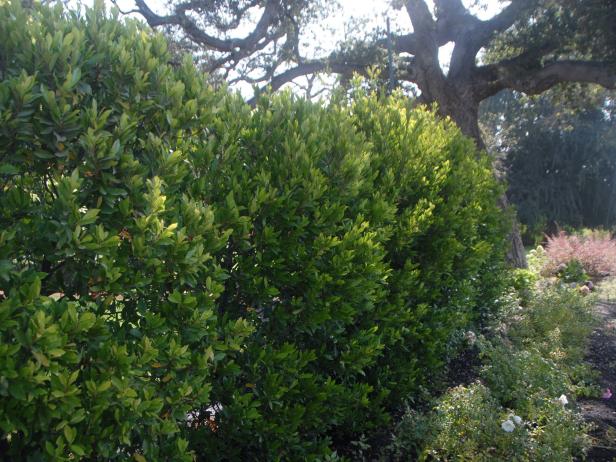
Courtesy of Monrovia
Bright 'N Tight Carolina laurel is a compact species.

.-Battle-on-the-Beach-courtesy-of-HGTV.-.jpg.rend.hgtvcom.196.196.suffix/1714761529029.jpeg)




